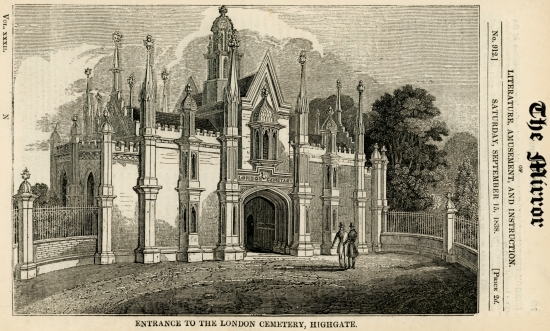At the entrance to Highgate Cemetery were two symmetrical mortuary chapels designed by Stephen Geary in a Tudor Gothic style, arranged lengthwise, linked by a porte-cochere at the centre. On the left is the Anglican Chapel, and on the right was one for Dissenters. Both were tiny. This is perhaps the first example of them being joined as a pair, later a commonplace of cemetery architecture, but the impression here is more one of a fortified gatehouse, especially with the words 'London Cemetery' over the centre. Geary was clearly inspired by the gatehouse of Kings College, Cambridge, completed only a decade earlier.
Unfortunately the exterior is now shorn of much of its detail above the crenellated parapets, missing in particular is the octagonal bell turret and a multitude of soaring pinnaces which gave it all the pizzazz of a firework waiting to go off. One contemporary wrote that although it had 'a showy and somewhat fanciful appearance,' its interior was appropriate 'for the solemn rites of religion'. This architectural exuberance fell out of favour with more sobre-minded later Victorians.
The room over the archway opened into a private gallery in the Anglican Chapel of which no trace survivies. It was used for infirm mourners, invalids, and women who would not attend the funeral service itself. It also functioned as a committee room and as an office for the cemetery superintendent.
The Dissenters' Chapel is now used as the cemetery office. Although externally it had the same dimensions as the Anglican Chapel, it provided in addition 'several retiring-rooms and the residences of the various officers of the establishment'. Perhaps actually little more than a room, the Dissenters' Chapel would always have been much less used for services than its neighbour, and you can almost imagine the gatekeeper clearing off his tablecloth and using his dining table as the bier.
When another 19 acres of land on the opposite side of Swain's Lane was purchased in 1854 the Anglican Chapel was virtually doubled in size by an extension. A hydraulic bier was installed in the new chancel which lowered coffins to the crypt below where they could be taken to the East side in a tunnel under the road, a requirement of the founding Act of Parliament.
The interior of the Anglican Chapel was restored in 2012 to a decorative scheme of around 1890 by the architect Jon Allen. A proposal to restore the pinnacles and cupola at an estimated cost of £1.6m is presently under consideration, subject to funding.
